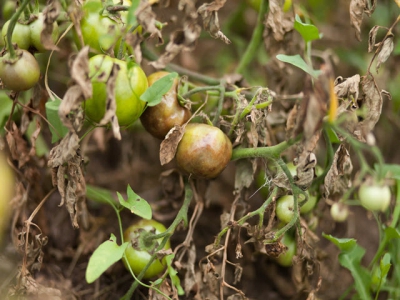Dont let late blight catch you napping

Late blight (Phytophthora infestans) is a fungus in a hurry, and may already have done much damage if you’re not awake and watching out for the conditions which favour it.
Late blight can destroy a crop in a couple of days if weather conditions are favourable.
There are two types. In South Africa we have A1, an asexually reproducing type. The spores formed are identical to the parent. Any deviation from this requires mutation, which is a slow process. A2 is a mating type. Genes are swapped during reproduction, meaning a greater chance of variants and thus a greater chance of developing strains resistant to fungicides. A2 is able to mate with A1.
A1 is the fungus which caused the great potato famine in Ireland in 1845. Then, during a drought in England in the 1970s, the authorities permitted the importation of potatoes from Mexico. With them came the A2 mating type, which has made controlling late blight on tomatoes and potatoes a bigger challenge in the UK.
Great distances
Late blight spores can travel great distances on wind currents. Cool, drizzly or cloudy weather with intermittent rain is ideal for their development. The temperature needs to be between 15°C and 25°C with free water on the leaves for about 12 hours. Leaf blight will attack leaves, stems and fruit. Once the first spores have settled on the crop and penetrated the plant cells, it will take a few days for the first spots to develop.
From one such spot, 100 000 to 300 000 spores can be produced every day as long as conditions remain favourable. These spots may only be 2mm to 3mm in diameter to start with and then spread out. It will attack leaves, stems and the fruit. If conditions become unfavourable due to a change in the weather, spore production and development stop until conditions become favourable again.
Intensive spraying
Having been exposed to late blight for a large part of my career, I’ve developed a ‘feel’ for when conditions favour P. infestans. I once visited a farmer in these conditions, and the first thing I asked was if he had any late blight on his crop. He said he hadn’t. But I visited the land anyway, and sure enough there were lesions here and there where the initial spores had started off.
Remember, you have to look closely for these signs – you won’t spot them just by walking down the rows. This is the time for intensive spraying to prevent the new spores from taking root. In the Mpumulanga Lowveld, where I farmed, farmers often started ‘panic spraying’ at this stage. In doing so, they would save the sections which could be sprayed before the spores germinated and they lost the rest.
Back then, we only had products with a prophylactic, or protective, action which included Dithane and coppers. It wasn’t always possible to get a sufficient break in the weather to spray the crop and the fungicide was often washed off by the next rain before drying.
Systemic products
These days you can use systemic products, which are able to kill off the fungus within the tissue. But you shouldn’t rely only on these, as you will get resistance build-up in the fungus. Use the other products to protect the foliage and employ the systemic only when symptoms start to develop. In any case, copper and dithiocarbimates will control a number of other tomato diseases as well. Discuss the best approach with your crop chemical specialist.
Fungal diseases have caused many tomato farmers to give up on this crop in very vulnerable areas. But this doesn’t mean that some areas will always be ‘safe’, as our weather is so unpredictable. Late blight has, however, lost its sting due to systemic products and resistant genes. The fungus started off in Central and South America, where wild species of potatoes and tomatoes occur. It’s among these wild species that resistant genes were discovered and introduced into modern varieties.
This is an additional back-up where varieties are available with the resistant genes and fruit-type required. We may have almost won the war against late blight, but we still need to be very diligent and know the conditions which favour this disease.
Có thể bạn quan tâm
 Be pro-active where early blight is a threat
Be pro-active where early blight is a threat Early blight (Alternaria solani) is a fungal disease that every tomato grower should know about. It’s sometimes referred to as ‘target spot’ as it forms concent
 Dealing with the African bollworm
Dealing with the African bollworm The African bollworm (Helicoverpa armigera) has many host crops. The caterpillar, which is spiny when young, has a light stripe on the sides and usually turns
 The value of nets in citrus and table grape production
The value of nets in citrus and table grape production The farm Matroozefontein has the most westerly citrus orchards and table grape vineyards in Southern Africa. In this arid area, farming under nets has proved